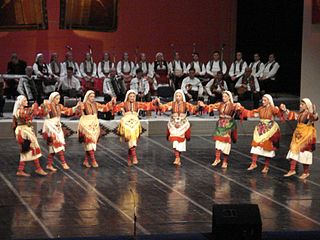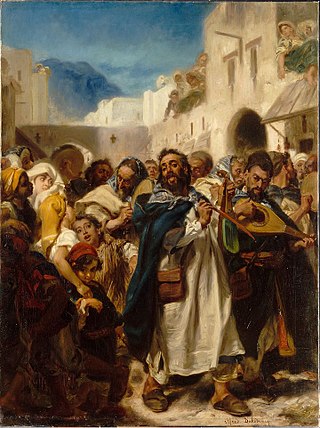External links
- Romanian Christmas traditions (in Romanian)
Irozii (singular Irod) were Romanian Orthodox minstrel shows, played in the Christmas season, centered on the figure of Herod the Great (Romanian : Irod) and the Massacre of the Innocents. Along with a New Year tradition of imitation peasant weddings, they are generally considered the origin of Romanian-language popular theater.
Irozii influenced the Purim plays of the Romanian Jews (generally credited as the origin of Yiddish theater) and vice versa. Thus, the origin of Romanian-language popular theater in the first half of the 19th century was echoed in the later origin (also in Romania) of Yiddish theater.
Typically performed by schoolteachers and deacons, irozii initially took place in the boyar's or lord's court; in later years, performances would be given in the salons of the grand houses. Irozii began to fade in the late 19th century; elaborate pageants are no longer common, though a less elaborate form continues.

Yiddish is a West Germanic language historically spoken by Ashkenazi Jews. It originated in 9th century Central Europe, and provided the nascent Ashkenazi community with a vernacular based on High German fused with many elements taken from Hebrew and to some extent Aramaic. Most varieties of Yiddish include elements of Slavic languages and the vocabulary contains traces of Romance languages. Yiddish has traditionally been written using the Hebrew alphabet.

A Christmas carol is a carol on the theme of Christmas, traditionally sung at Christmas itself or during the surrounding Christmas holiday season. The term noel has sometimes been used, especially for carols of French origin. Christmas carols may be regarded as a subset of the broader category of Christmas music.

Klezmer is an instrumental musical tradition of the Ashkenazi Jews of Central and Eastern Europe. The essential elements of the tradition include dance tunes, ritual melodies, and virtuosic improvisations played for listening; these would have been played at weddings and other social functions. The musical genre incorporated elements of many other musical genres including Ottoman music, Baroque music, German and Slavic folk dances, and religious Jewish music. As the music arrived in the United States, it lost some of its traditional ritual elements and adopted elements of American big band and popular music. Among the European-born klezmers who popularized the genre in the United States in the 1910s and 1920s were Dave Tarras and Naftule Brandwein; they were followed by American-born musicians such as Max Epstein, Sid Beckerman and Ray Musiker.

The culture of Moldova is unique and influenced by the Romanian origins of its majority population, as well as the Slavic and minority Gagauz populations. The traditional Latin origins of Romanian culture reach back to the 2nd century, the period of Roman colonization in Dacia.

Hora, also known as horo and oro, is a type of circle dance originating in Romania and Bulgaria. Other types of circle dances called with similar names are found in other South East European countries and culturally adopted by ethnic minorities such as the Ashkenazi Jews, Sephardic Jews and the Roma.

Teatrul Evreiesc de Stat in Bucharest, Romania is a theater specializing in Jewish-related plays. It is the oldest Yiddish-language theater with uninterrupted activity in the world. Its contemporary repertoire includes plays by Jewish authors, plays on Jewish topics, and plays in Yiddish. Many of the plays also feature Jewish actors.

Pastrami is a type of cured meat originating from Romania usually made from beef brisket. The raw meat is brined, partially dried, seasoned with herbs and spices, then smoked and steamed. Like corned beef, pastrami was originally created as a way to preserve meat before the invention of refrigeration. One of the iconic meats of Eastern European cuisine as well as American Jewish cuisine and New York City cuisine, hot pastrami is typically served at delicatessen restaurants on sandwiches such as the pastrami on rye.
Yiddish theatre consists of plays written and performed primarily by Jews in Yiddish, the language of the Ashkenazi Jewish community. The range of Yiddish theatre is broad: operetta, musical comedy, and satiric or nostalgic revues; melodrama; naturalist drama; expressionist and modernist plays. At its height, its geographical scope was comparably broad: from the late 19th century until just before World War II, professional Yiddish theatre could be found throughout the heavily Jewish areas of Eastern and East Central Europe, but also in Berlin, London, Paris, Buenos Aires and New York City.

Jewish culture is the culture of the Jewish people, from its formation in ancient times until the current age. Judaism itself is not simply a faith-based religion, but an orthoprax and ethnoreligion, pertaining to deed, practice, and identity. Jewish culture covers many aspects, including religion and worldviews, literature, media, and cinema, art and architecture, cuisine and traditional dress, attitudes to gender, marriage, family, social customs and lifestyles, music and dance. Some elements of Jewish culture come from within Judaism, others from the interaction of Jews with host populations, and others still from the inner social and cultural dynamics of the community. Before the 18th century, religion dominated virtually all aspects of Jewish life, and infused culture. Since the advent of secularization, wholly secular Jewish culture emerged likewise.
The Broderzinger or Broder singers, from Brody in Ukraine, were Jewish itinerant performers in Austrian Galicia, Romania, and Russia, professional or semiprofessional songwriters and performers, who from at least the early 19th century sang and danced, often in comic disguises, and who performed short one-act plays. They were often badchonim and meshorerim. They were among the first to publicly perform Yiddish-language songs outside of Purim plays and wedding parties, and were an important precursor to Yiddish theatre. They erected miniature stages and entertained customers in taverns, wine cellars, and restaurant gardens.
Berl Broder (1817–1868), born Berl Margulis, was a Ukrainian Jew born in Podkamen, the most famous of the Broder singers and reputed the first to be both a singer and an actor. His nickname is the origin of the term Broder singer. Thirty of his songs survive; of these, 24 are in the form of dialogues, usually between craftsmen such as tailors or shoemakers; his songs are seen as a precursor to Yiddish theater.
Isidor Goldenberg (1870–?) was a Romanian Jewish singer and actor, prominent in Yiddish theater in the late 19th and early 20th century.

Hersh Leib Sigheter (1829–1930), pen name of Hersh (Hirsch) Leib Gottlieb גוטליב was a Hungarian Jew from today's Sighetu Marmaţiei, Romania who, even before the advent of what is generally considered to be professional Yiddish theater, wrote satirical Yiddish-language Purim plays on an annual basis and hired boys to play in them. Although often objected to by rabbis, these plays were popular, and were performed not only on Purim but for as much as a week afterwards in various locations.

Yankev Shternberg was a Yiddish theater director, teacher of theater, playwright, avant-garde poet and short-story writer, best known for his theater work in Romania between the two world wars.
The Vilna Troupe, also known as Fareyn Fun Yiddishe Dramatishe Artistn and later Dramă şi Comedie, was an international and mostly Yiddish-speaking theatre, one of the most famous in the history of Yiddish theater. It was formed in and named after the city of Vilnius (Vilna) in the Russian Empire, later capital city of Lithuania. Distinctly Modernist, and strongly influenced by Russian literature and by the ideas of Konstantin Stanislavski, their travels in Western Europe and later to Romania played a significant role in the dissemination of a disciplined approach to acting that continues to be influential in the present day.
Ni-be-ni-me-ni-cucurigu is an 1878 play by Abraham Goldfaden. The somewhat nonsensical Yiddish title is variously translated as Not Me, Not You, Not Cock-a-Doodle-Doo or Neither This, Nor That, nor Kukerikoo; Lulla Rosenfeld says it had an alternate title The Struggle of Culture with Fanaticism. The title comes from a Russian expression "ни бе, ни ме, ни кукареку", meaning to understand nothing on the subject.

The Yiddish King Lear was an 1892 play by Jacob Gordin, and is generally seen as ushering in the first great era of Yiddish theater in New York City’s Yiddish Theater District, in which serious drama gained prominence over operetta.

The Yule goat is a Scandinavian and Northern European Yule and Christmas symbol and tradition. Its origin is from Germanic paganism and has existed in many variants during Scandinavian history. Modern representations of the Yule goat are typically made of straw.

Yiddish dialects are varieties of the Yiddish language and are divided according to the region in Europe where each developed its distinctiveness. Linguistically, Yiddish is divided in distinct Eastern and Western dialects. While the Western dialects mostly died out in the 19th-century due to Jewish language assimilation into mainstream culture, the Eastern dialects were very vital until most of Eastern European Jewry was wiped out by the Shoah.

The Irving Place Theatre was located at the southwest corner of Irving Place and East 15th Street in the Union Square neighborhood of Manhattan, New York City. Built in 1888, it served as a German language theatre, a Yiddish theatre, a burlesque house, a union meeting hall, a legitimate theatre and a movie theatre. It was demolished in 1984.